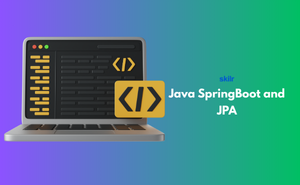👇 CELEBRATE CLOUD SECURITY DAY 👇
00
HOURS
00
MINUTES
00
SECONDS

SpringBoot is a Java framework designed to reduce the hassle of application development. It comes with pre-configured tools and libraries that allow developers to launch projects quickly. Instead of manually managing settings, developers can start coding features right away, making the process smoother and faster.
The Java Persistence API, or JPA, provides a structured way to handle database operations. It allows developers to work with data using Java objects, reducing the need for complex SQL commands. When combined with SpringBoot, JPA enables the creation of scalable, database-driven applications in a more efficient manner.
This exam is ideal for:
Domain 1 - Introduction to SpringBoot & JPA
Domain 2 - SpringBoot Basics
Domain 3 - Building REST APIs with SpringBoot
Domain 4 - Database Connectivity with JPA
Domain 5 - Advanced JPA Concepts
Domain 6 - Spring Data JPA
Domain 7 - SpringBoot with Microservices
Domain 8 - Security & Deployment
Domain 9 - Testing & Best Practices
Industry-endorsed certificates to strengthen your career profile.
Start learning immediately with digital materials, no delays.
Practice until you’re fully confident, at no additional charge.
Study anytime, anywhere, on laptop, tablet, or smartphone.
Courses and practice exams developed by qualified professionals.
Support available round the clock whenever you need help.
Easy-to-follow content with practice exams and assessments.
Join a global community of professionals advancing their skills.
Yes, basic understanding of Java is required.
IT services, e-commerce, finance, healthcare, startups, and enterprise solutions.
No, it is useful for both small and large applications.
It enhances their backend knowledge and database integration skills.
Anyone with a background in Java or interest in backend development.
REST API development, JPA, microservices basics, and deployment practices.
With growing demand for scalable applications, professionals with SpringBoot and JPA expertise have strong career prospects.
Yes, basics of microservices with SpringBoot are included.
It opens roles like Java developer, backend engineer, and software architect.
Yes, SpringBoot and JPA are widely used in global software development.
They simplify development and database management, making applications faster to build.
Yes, practical applications and case studies are part of the curriculum.
It strengthens their skills in API building and database handling.
It helps developers interact with databases using Java objects.
Yes, it is suitable for beginners with Java knowledge.